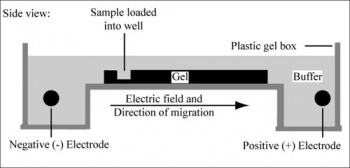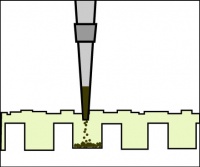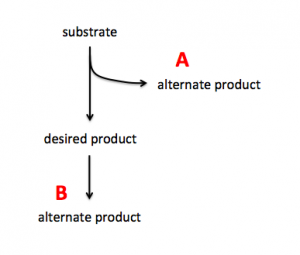Difference between revisions of "20.109(F16):Design gRNA for CRISPRi (Day2)"
Noreen Lyell (Talk | contribs) (→Part 2: Select E. coli fermentation pathway protein to target) |
Noreen Lyell (Talk | contribs) (→Part 2: Select E. coli fermentation pathway protein to target) |
||
| Line 37: | Line 37: | ||
#Which gene(s) might you target to decrease the amount of substrate used to generate products in steps downstream of ethanol production? For acetate production? | #Which gene(s) might you target to decrease the amount of substrate used to generate products in steps downstream of ethanol production? For acetate production? | ||
[[]] <br> | [[]] <br> | ||
| − | With your laboratory partner, review [[Media:MetEngEcoli review.pdf |Metabolic engineering of ''Escherichia coli'' for production of mixed-acid fermentation end products]] by Forster & Gescher. Using the information within this article and the genes that you identified above, select one gene that you will target to increase production of either ethanol or lactate. Be sure to include notes on your decision and thought process in your laboratory notebook. | + | With your laboratory partner, review [[Media:MetEngEcoli review.pdf |Metabolic engineering of ''Escherichia coli'' for production of mixed-acid fermentation end products]] by Forster & Gescher. Using the information within this article and the genes that you identified above, select one gene that you will target in an attempt to increase the production of either ethanol or lactate. Be sure to include notes on your decision and thought process in your laboratory notebook. |
===Part 3: Design gRNA for CRISPRi system=== | ===Part 3: Design gRNA for CRISPRi system=== | ||
Revision as of 19:06, 26 July 2016
Contents
Introduction
Brief CRISPR(i)...
Metabolic engineering...
Protocols
During your last laboratory session you completed an experiment to confirm the pdCas9 plasmid. Today you will examine the results of your digests and perform the next stage of preparatory work by selecting a target for your system engineering project. Upon determining which gene you will target, you will design a gRNA specific to your target.
Part 1: Agarose gel electrophoresis of confirmation digests
Electrophoresis is a technique that separates large molecules by size using an applied electrical field and a sieving matrix. DNA, RNA and proteins are the molecules most often studied with this technique; agarose and acrylamide gels are the two most common sieves. The molecules to be separated enter the matrix through a well at one end and are pulled through the matrix when a current is applied across it. The larger molecules get entwined in the matrix and are stalled; the smaller molecules wind through the matrix more easily and travel further from the well. The distance a DNA fragment travels is inversely proportional to the log of its length. Over time fragments of similar length accumulate into “bands” in the gel. Higher concentrations of agarose can be used to resolve smaller DNA fragments.
DNA and RNA are negatively charged molecules due to their phosphate backbone, and they naturally travel toward the positive charge at the far end of the gel. Today you will separate DNA fragments using an agarose matrix. Agarose is a polymer that comes from seaweed and if you’ve ever made Jell-O™, then you already have all the skills needed for pouring an agarose gel! To prepare these gels, agarose and 1X TAE buffer are microwaved until the agarose is melted and fully dissolved. The molten agar is then poured into a horizontal casting tray, and a comb is added. Once the agar has solidified, the comb is removed, leaving wells into which the DNA sample can be loaded.
You will use a 1% agarose gel (prepared by the teaching faculty) to separate the DNA fragments in your four digested samples as well as a reference lane of molecular weight markers (also called a DNA ladder).
- Add 5 μL of 6x loading dye to the digests.
- Loading dye contains bromophenol blue as a tracking dye to follow the progress of the electrophoresis (so you don’t run the smallest fragments off the end of your gel!) as well as glycerol to help the samples sink into the well.
- Flick the eppendorf tubes to mix the contents, then quick spin them in the microfuge to bring the contents of the tubes to the bottom.
- Load 25 μL of each digest into the gel, as well as 20 μL of 1kb DNA ladder.
- Be sure to record the order in which you load your samples!
- To load your samples, draw the volume listed above into the tip of your P200 or P20. Lower the tip below the surface of the buffer and directly over the well. You risk puncturing the bottom of the well if you lower the tip too far into the well itself (puncturing well = bad!). Expel your sample into the well. Do not release the pipet plunger until after you have removed the tip from the gel box (or you'll draw your sample back into the tip!).
- Once all the samples have been loaded, attach the gel box to the power supply and run the gel at 125 V for no more than 45 minutes.
Part 2: Select E. coli fermentation pathway protein to target
Your goal in this module is to increase the production of either ethanol or lactate, two valuable products of the E. coli fermentation pathway. You will complete this task using the CRISPRi system, which targets genes such that transcription of the target gene is decreased, thus resulting in less of the protein encoded by the targeted gene.
To increase production of a desired product, you can either target proteins that use the substrate to generate alternate products (see A in image on right) or you can target proteins that use the desired product to generate alternate products (see B in image on right). In A the substrate is siphoned away from the reaction that generates the desired product and in B the desired product is used as substrate in a subsequent reaction. By eliminating the proteins that catalyze the reactions that result in alternate products, you can potentially increase production of your desired product.Use the fermentation pathway from E. coli (included below) and the example above to answer the following questions with your partner.
- Which gene(s) might you target to increase the availability of substrate for ethanol production? For acetate production?
- Which gene(s) might you target to decrease the amount of substrate used to generate products in steps downstream of ethanol production? For acetate production?
[[]]
With your laboratory partner, review Metabolic engineering of Escherichia coli for production of mixed-acid fermentation end products by Forster & Gescher. Using the information within this article and the genes that you identified above, select one gene that you will target in an attempt to increase the production of either ethanol or lactate. Be sure to include notes on your decision and thought process in your laboratory notebook.
Part 3: Design gRNA for CRISPRi system
Reagents
Next day: [[



